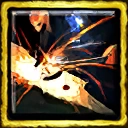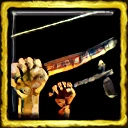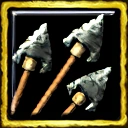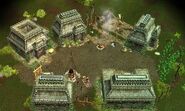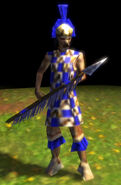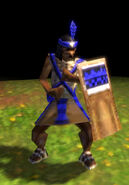(Restored history section) |
Nikitazero (talk | contribs) mNo edit summary |
||
| Line 2: | Line 2: | ||
{{Infobox Civ |
{{Infobox Civ |
||
|civ = Inca |
|civ = Inca |
||
| − | |flag = |
+ | |flag = Inca_Icon.png |
|caption = The Inca Trading Post icon |
|caption = The Inca Trading Post icon |
||
|game = ''[[Age of Empires III]]'' |
|game = ''[[Age of Empires III]]'' |
||
| Line 9: | Line 9: | ||
|techs = Inca Metalworking<br/>Inca Chasquis Messengers<br/>Inca Road-building<br/>Inca Warrior Societies<br/>Champion Inca |
|techs = Inca Metalworking<br/>Inca Chasquis Messengers<br/>Inca Road-building<br/>Inca Warrior Societies<br/>Champion Inca |
||
|maps = [[Andes]]<br/>[[Araucania]]<br/>[[Pampas]] |
|maps = [[Andes]]<br/>[[Araucania]]<br/>[[Pampas]] |
||
| + | |minor = 1 |
||
}} |
}} |
||
The '''[[Wikipedia:Inca Empire|Inca]]''' is a [[Native Americans|Native American]] tribe in ''[[Age of Empires III]]''. Like all natives, they can be allied with by building a [[Trading Post]] at their Trading Post site. |
The '''[[Wikipedia:Inca Empire|Inca]]''' is a [[Native Americans|Native American]] tribe in ''[[Age of Empires III]]''. Like all natives, they can be allied with by building a [[Trading Post]] at their Trading Post site. |
||
Revision as of 15:56, 26 January 2019
| This article is about the civilization in Age of Empires III. For their Age of Empires II: The Forgotten appearance, see Incas (Age of Empires II). |
Template:Infobox Civ The Inca is a Native American tribe in Age of Empires III. Like all natives, they can be allied with by building a Trading Post at their Trading Post site.
The Inca are available on the Andes, Araucania and Pampas maps.
Units
- Inca Huaminca: Similar to the Maya Holcan Spearman, however it has higher melee damage, resistance and it has better siege damage. It suffers from the slow siege attack (4.0 vs. 3.0 for most units), so like the Holcan Spearman some units may deal better siege damage over time. Otherwise it is more potent than a regular Pikeman. Up to 13 may be trained per tribe.
- Inca Bolas Warrior: They are the only ranged infantry units to possess splash damage. This can quickly kill their favored enemies if the opponent does not activate stagger mode on the units. For civilizations with aura effects such as the Japanese (Golden Pavilion, Daimyo/Shogun bonuses), or the Spanish (unction card) they can become a very powerful addition to an army. Up to 6 may be trained per tribe.
Upgrades
Incan upgrades are some of the best in the game. They focus on boosting an allies economy, and troop training and movement speed.
| Age | Icon | Improvement | Cost | Effect |
|---|---|---|---|---|
| Inca Metalworking | 175 food, 175 coin | Settlers/Villagers gather Coin from mines 20% faster | ||
| Inca Chasquis Messengers | 250 food, 250 coin | Infantry and cavalry train 25% faster; artillery train 10% faster | ||
| Inca Road-building | 300 food, 300 coin | Infantry get +20% speed | ||
| Inca Warrior Societies | 300 wood, 200 coin | Upgrades Huamincas and Bolas Warriors to Elite | ||
| Champion Inca | 500 wood, 400 coin | Upgrades Huamincas and Bolas Warriors to Champion |
Usefulness
- Incan Metalworking can be quite powerful for civilizations who send Home City cards to stack with the upgrade or civilizations which already have superior mining rates (French due to Coureurs, Dutch due to bonus in mining speed). However this upgrade is of limited usefulness if the map does not have many mines available.
- Incan Chasquis Messengers is possibly the most important upgrade for a Treaty game, significantly improving unit train times. No civilization should pass it up in long running games if they have the resources and trading post needed.
- Incan Road-building is useful for civilizations which have Home City cards that boosts their infantry units' speed. The Japanese can boost their Samurai speed by 10% with the Sword Saint card, purchase the upgrade and switch their Golden Pavilion aura effect to one which increases infantry movement speed even further, the Germans have a unique church technology after a card shipment which gives infantry 20% more speed, and Dutch Halberdiers move quite fast (mitigating their primary weakness) when this improvement is combined with the Military Reforms card.
- It can also be useful for the Spanish, whose church upgrade Corselet lowers heavy infantry movement speed by 15% in exchange for 25% greater hit points. With this upgrade the penalty is countered completely and the units still gain a small speed boost.
- Civilizations with access to Arsenal upgrades can further increase the speed of their units by 10% with Military Drummers.
- Inca unit upgrades cost more than other minor civilizations', this is for balancing purposes.
In-game dialogue
They speak a variety of the language Rune Simi, the Quechuan Simi.
- Ari (Yes!)
- Gorriya
- Chjaaku
- Mut'uy (Fell)
- Jap'iy (Hunt)
- Jai (What?)
- Aytippe (Attack!)
- Qu'utiya (Attack)
History
| “ | The civilization we now call the Inca appeared as a small tribal group in the southern Peruvian Andes around 1200 CE, possibly migrating from Lake Titicaca. They emphasized community responsibility and mutual aid in the face of recurring wars with neighboring tribes. One of these struggles in the early fifteenth century led to the beginnings of imperial conquest. Two successive strong Incan leaders rapidly expanded their empire, which at its peak stretched over thousands of miles in mountainous terrain, from Ecuador along the Peruvian coast to southern Chile. The empire was spread less by war than by negotiation, alliances, and even bribery. The Inca seem to have been driven by the desire to spread their religious belief in a Sun cult. The Inca were remarkable for their system of roads and couriers, and a complex irrigation system that made extensive farming possible in remote locations. Without writing, they did develop a complex counting system that used knots in colored threads called quimpos. Their cities and architecture were astounding, especially the massive stonework of incredible precision, assembled without metal tools. The Spanish under Francisco Pizzaro appeared at a time when the Inca had just resolved a civil war between two brothers. The new emperor misjudged the small Spanish force and was captured. He offered a huge ransom of gold and silver, but Pizzaro reneged when the treasure was delivered, and executed his hostage. In a brutal campaign, the core of the Incan Empire was quickly overrun. By 1540, most of Latin America was in Spanish hands. The Inca were largely subjugated and forced to work on Spanish estates. | ” |
| —In-game history section | ||
Gallery
Alternate Inca Trading Post icon, note the slight color variations compared to the Bolas Warrior icon
Template:Civilizations (AoE3)

